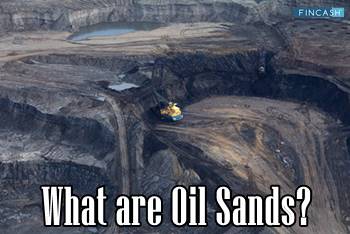Defining Oil Sands
Oil sands, commonly known as "tar sands," are sedimentary rocks of sand, clay particles, water, and bitumen. The oil is bitumen, a highly heavy liquid or sticky black solid with a low melting point. Bitumen generally accounts for 5 to 15% of the deposit.

Oil sands are part of crude oil commodities. These are found largely in the Athabasca, Cold Lake, and Peace River regions of northern Alberta and Saskatchewan, Canada, and in Venezuela, Kazakhstan, and Russia.
Uses of Oil Sands
The majority of oil sands is processed for use in gasoline, aviation fuel, and home heating oil. But before it can be used for anything, it must first be extracted from the sand and then processed.
Where is Oil Sands Located?
Oil sands contain more than 2 trillion barrels of the world's petroleum, yet the majority will never be extracted and processed due to their depth. Oil sands can be found worldwide, from Canada to Venezuela to the Middle East. Alberta, Canada, has a thriving oil-sands sector, producing 1 million barrels of synthetic oil per day, 40% of which originates from oil sands.
Oil Sands Products
Oil sands plants generate a heavy commercial diluted bitumen (often known as Dilbit) or a light synthetic crude oil. Dilbit is heavy corrosive crude, whereas synthetic crude is a light sweet oil that can only be created by upgrading bitumen. Both are sold to refineries for further processing into finished goods.
Talk to our investment specialist
Oil Sands Production
Although only Canada has a large-scale commercial oil sands business, bituminous sands constitute a significant source of unconventional oil. In 2006, bitumen production in Canada averaged 1.25 Mbbl/d (200,000 m3/d) from 81 oil grains of sand operations. In 2007, oil sands accounted for 44% of Canadian oil output.
This share was predicted to rise in the next decades as bitumen production rose while conventional oil output fell; however, owing to the 2008 economic slump, the development of new projects has been postponed. Other countries do not generate a large amount of petroleum from oil sands.
Oil Sands Extraction
Depending on how deep the deposits are below the surface, bitumen can be produced using one of two methods:
In-Situ Production
In-situ extraction, technologies are utilised to collect bitumen that is too deep under the surface (greater than 75 meters underground) for mining. Currently, in-situ technology can reach 80% of oil sand deposits. Steam Assisted Gravity Drainage (SAGD) is the most often utilized in-situ recovery technology.
This approach entails drilling two horizontal wells into the oil sands deposit, one slightly higher than the other. Steam is continually fed into the top well, and as the temperature rises in the "steam chamber," the bitumen becomes more fluid and flows to the lower well. Then, bitumen is pumped into the surface.
Surface Mining
It is similar to regular mineral mining techniques and is commonly used where oil sand deposits are near the surface. Currently, mining techniques can reach 20% of oil sand deposits.
Big shovels sweep the oil sand onto trucks, transporting it to crushers, grinding the large clumps of soil. After crushing the oil sand, hot water is added to be piped to the extraction Facility. More hot water is added to this mixture of sand, clay, and bitumen in a huge separation tank at the extraction facility. A setpoint is allotted for the different components to separate. Bitumen froth comes to the surface during separation and is removed, diluted, and refined further.
Tar Sands Oil vs Crude Oil
Oil sands refer to a type of unconventional oil deposit found worldwide. It is also known as tar sands, a combination of sand, clay, other minerals, water, and bitumen. Bitumen is a kind of crude oil that can be extracted from the mixture. It is extremely thick and dense in its natural condition. The natural bitumen is treated or diluted to transport the oil sands.
Crude oil is a kind of liquid petroleum discovered underground. Its density, viscosity, and sulfur content vary greatly depending on where it is discovered and the conditions under which it was formed. Oil firms refine crude oil into usable products, including gasoline, home heating oil, diesel fuel, aviation gasoline, jet fuels, and kerosene.
Crude oil can also be turned into chemicals used to manufacture a broad Range of items, including clothes, cosmetics, and medications.
Oil Sands Environmental Impact
The mining and processing of oil sands have a variety of environmental impacts. These include:
- Greenhouse gas emissions
- Land disturbance
- Wildlife habitat damage
- Local water quality degradation
Water problems are especially critical since the known oil sands, and oil shale reserves are situated in dry parts. For every barrel of oil produced, many barrels of water are required.
Takeaway
The final result of oil sands is extremely comparable to, if not better than, that of conventional oil, which is extracted using oil rigs. Due to the sheer extensive mining, extraction, and upgrading operations, oil from oil sands is often more expensive to produce than oil from traditional sources and is environmentally harmful.
The extraction of bitumen from oil sands produces considerable emissions, destroys the soil, has detrimental effects on animals, pollutes the local water supply, and much more. Despite the severe environmental impact, oil sands generate considerable revenue for the Economy, heavily reliant on oil sands.
All efforts have been made to ensure the information provided here is accurate. However, no guarantees are made regarding correctness of data. Please verify with scheme information document before making any investment.












